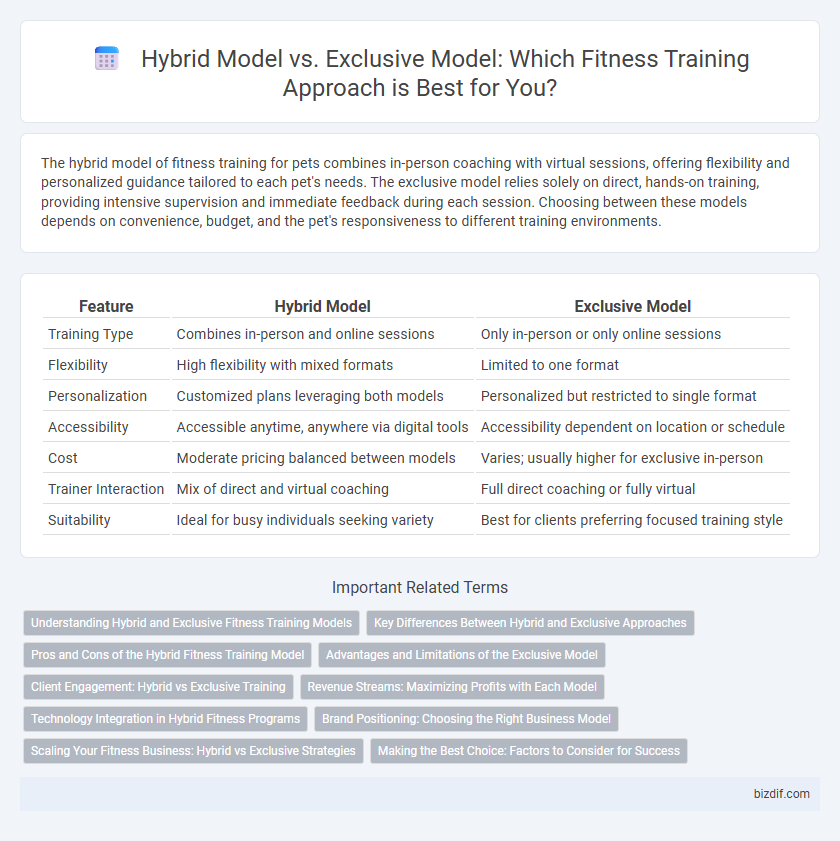The hybrid model of fitness training for pets combines in-person coaching with virtual sessions, offering flexibility and personalized guidance tailored to each pet's needs. The exclusive model relies solely on direct, hands-on training, providing intensive supervision and immediate feedback during each session. Choosing between these models depends on convenience, budget, and the pet's responsiveness to different training environments.
Table of Comparison
| Feature | Hybrid Model | Exclusive Model |
|---|---|---|
| Training Type | Combines in-person and online sessions | Only in-person or only online sessions |
| Flexibility | High flexibility with mixed formats | Limited to one format |
| Personalization | Customized plans leveraging both models | Personalized but restricted to single format |
| Accessibility | Accessible anytime, anywhere via digital tools | Accessibility dependent on location or schedule |
| Cost | Moderate pricing balanced between models | Varies; usually higher for exclusive in-person |
| Trainer Interaction | Mix of direct and virtual coaching | Full direct coaching or fully virtual |
| Suitability | Ideal for busy individuals seeking variety | Best for clients preferring focused training style |
Understanding Hybrid and Exclusive Fitness Training Models
Hybrid fitness training models combine strength, cardio, and flexibility exercises into a balanced regimen, optimizing overall body performance and adaptability. Exclusive fitness training models focus intensively on one specific area, such as strength training or endurance, to maximize specialization and targeted results. Understanding the benefits and limitations of each helps individuals tailor programs to their fitness goals and lifestyle.
Key Differences Between Hybrid and Exclusive Approaches
Hybrid fitness training combines in-person sessions with virtual workouts, offering flexibility and personalized guidance, while exclusive training relies solely on one mode, either fully in-person or entirely online. The hybrid model enhances engagement by integrating digital tracking tools and real-time feedback, whereas exclusive models may limit adaptability based on location or schedule. Performance outcomes often improve with hybrid approaches due to diversified training stimuli and consistent monitoring.
Pros and Cons of the Hybrid Fitness Training Model
The hybrid fitness training model combines in-person and virtual workouts, offering flexibility and personalized coaching while accommodating varying schedules. It enhances motivation through social interaction and accountability but may face challenges in maintaining consistent technique correction compared to exclusive in-person sessions. Hybrid training leverages technology for progress tracking but can lack the immersive environment and immediate feedback found in fully exclusive gym-based programs.
Advantages and Limitations of the Exclusive Model
The Exclusive Model in fitness training offers personalized attention and tailored workout plans, enhancing client engagement and maximizing results through focused coaching. Limitations include reduced scheduling flexibility and limited access to diverse training modalities compared to a Hybrid Model, potentially restricting overall fitness development. Clients seeking specialized, consistent guidance benefit most from this model despite its narrower scope.
Client Engagement: Hybrid vs Exclusive Training
Hybrid fitness training integrates both in-person and virtual sessions, enhancing client engagement by offering flexible scheduling and personalized support that adapts to individual lifestyles. Exclusive training, typically centered on face-to-face interaction, fosters deeper real-time motivation and immediate feedback, which can boost accountability and technique precision. Research shows hybrid models increase overall client adherence rates by up to 30% due to the convenience and consistent communication channels they provide.
Revenue Streams: Maximizing Profits with Each Model
The Hybrid Model combines in-person and virtual fitness sessions, diversifying revenue streams through membership fees, pay-per-class options, and digital content sales, leading to increased profitability. In contrast, the Exclusive Model relies heavily on a single revenue source, typically in-person training packages, which can limit earning potential and market reach. Maximizing profits requires leveraging the Hybrid Model's flexibility to attract a broader client base and capitalize on multiple income channels simultaneously.
Technology Integration in Hybrid Fitness Programs
Hybrid fitness programs leverage advanced technology integration, combining in-person coaching with digital platforms such as apps, wearable devices, and virtual workout sessions to deliver personalized training and real-time progress tracking. Exclusive models, relying solely on either traditional gym environments or fully virtual setups, often lack the seamless data synchronization and adaptive feedback enabled by hybrid systems. This technological fusion enhances user engagement, optimizes workout efficiency, and supports continuous performance monitoring, setting hybrid models apart as the future standard in fitness training.
Brand Positioning: Choosing the Right Business Model
Hybrid model fitness brands combine in-person training with online programs, maximizing market reach and catering to diverse customer preferences. Exclusive model brands emphasize specialized, high-touch experiences, fostering strong community loyalty and higher perceived value. Selecting the right business model depends on target audience behavior, scalability goals, and long-term brand positioning strategy.
Scaling Your Fitness Business: Hybrid vs Exclusive Strategies
Scaling your fitness business requires choosing between hybrid and exclusive models, each offering unique growth opportunities. Hybrid models combine in-person and online training, expanding client reach while optimizing resource use. Exclusive models focus on specialized, high-value sessions, driving premium pricing but limiting market scalability.
Making the Best Choice: Factors to Consider for Success
Choosing between a hybrid fitness training model and an exclusive model depends on individual goals, schedule flexibility, and preferred workout variety. The hybrid model combines in-person and virtual sessions, offering adaptability and personalized feedback, while the exclusive model maximizes focused, consistent routines either fully online or offline. Success factors include training consistency, access to professional coaching, and the ability to stay motivated within the chosen format.
Hybrid Model vs Exclusive Model Infographic

 bizdif.com
bizdif.com